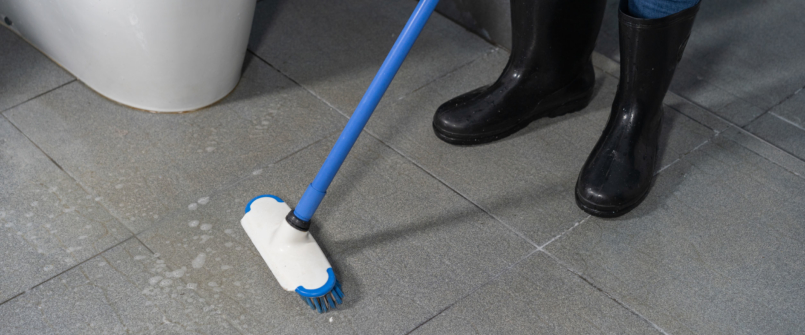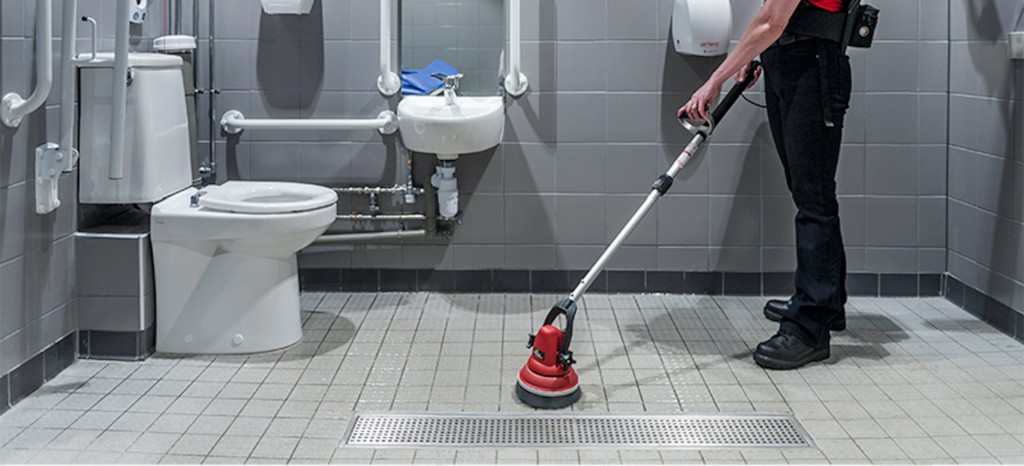
Dirty, Dingy Grout? Here’s How to Clean It
Tile is the flooring of choice for commercial building entryways, professional kitchens and public restrooms. But maintaining the grout in-between those tiles can be a huge maintenance challenge. Discoloration, soiling, odors and even corrosion can all affect the look and performance of floors and create a negative impression of your facility, not to mention contribute to slips and falls. Proper cleaning procedures and products will help keep all your tiled areas clean, inviting and safe as well as prolong the life of your flooring investment.
Holding the Line on Dirty Grout
The cement-like properties of grout are excellent for filling the space between tiles and protecting their edges from damage. But grout is also porous and acts like a sponge, soaking up any liquids that come in contact with it. Contaminants or dirt contained in those liquids can adhere to the grout. Once absorbed they are difficult to remove. Mopping or other regular cleaning methods aren’t effective at removing stains and may make problems worse, since rewetting can activate bacteria and cause odors.
Why Clean Grout?
In addition to improving the look of your facility floors there are several excellent reasons to keep on top of grout maintenance.
- Improves cleanliness – A clean facility makes a good impression on customers and boosts morale among employees. One survey found that 94% of U.S. adults said they would avoid a business in the future if they experienced a dirty restroom.*
- Increases safety – Clean grout offers better traction for foot traffic, making slip and fall accidents less likely for employees and customers.
- Eliminates odors – Regular floor cleaning treats the surface but does not remove contaminants embedded in grout. In fact, certain procedures like mopping may send soils and bacteria deeper into grout. Deep cleaning your grout can get to the source of odors and remove them for good.
- Protects health – Bacteria and mold can live and breed in damp grout, particularly in restrooms. It can also affect indoor air quality. Removing this bacteria will have an immediate positive effect on health of your facility.
- Extends floor life – Removing dirt and contaminants helps grout and tile last longer and look better, protecting your facility investment.
Brighter Days Ahead
Fortunately, a few steps on your part will ensure cleaner, brighter grout. Follow these steps and tips to get your floors looking their best:
Step One – ID the soil
Similar to other types of cleaning, the first step in grout cleaning is to determine which soil has caused your stain, discoloration, or odor. This will enable you to choose an appropriate product to clean your grout. If you’re not sure, you can usually narrow down the culprit by location. Building entrances, for example, often have a buildup of soil, sand, and icy salt tracked in from shoes, while restroom grout stains are usually the result of urine and/or mold and mildew. Kitchen area grout is often embedded with greasy animal fats and proteins.
Step Two – Choose the correct chemical
Once you know what soil you’re dealing with, you can move on to selecting a cleaning chemical. With any product used, it’s important to follow the manufacturer’s directions, including instructions for dilution, as using too much chemical can result in sticky floors that only serve to further attract soils.
Kitchens and Dining Areas – Grease deposits left on grout can become a slip and fall hazard. Use a product that both cleans and degreases. SureGrip can be used daily or for more intensive tile and grout cleaning to improve surface traction and safety. It emulsifies and suspends oils, greases and other food contaminates so they can be easily lifted from porous areas and removed.

Photo used with permission of Motor Scrubber.
Restrooms – Restroom floors can be affected by a variety of soils. In addition to those brought in through foot traffic, damp areas can breed algae, mold and mildew, spreading germs and affecting indoor air quality. Cleaners containing hydrogen peroxide are the product of choice for this area. GO2 Concentrate contains hydrogen peroxide and uses color-safe oxygen bleaching to keep grout white and bright. With no hazardous ingredients GO2 is safe enough to use every day. Uric acid can be a problem in grout near toilets and urinals, causing stains and hard-to-remove odors. Arrest contains enzymes formulated to break down uric acid crystals. It removes the bacterial source of odors and makes grout look new.
| TIP: For a more detailed look at restroom cleaning—including floors— reference this article. |
Entrances/Common Areas – High traffic areas are important ones to clean grout, with buildups of soil, sand and salt in building entrances. SureGrip Traction Daily Floor Cleaner Degreaser is designed to penetrate micro-pores, breaking up the cause of stains and lifting soils to the surface so they can be removed. It can be used for deep cleaning or daily maintenance.
| TIP: Heavily soiled areas need more water when cleaning. Be sure to use enough water to liquefy dirt. If using an auto scrubber, use a high water setting. |
Step Three – Use specialized grout cleaning equipment
Once you’ve removed any loose soil by sweeping or vacuuming, you’re ready to deploy specialized grout-cleaning equipment. Ideally, you’ll want to use an auto scrubber with a cylindrical brush attachment to get between tiles. A motor scrubber is handy for use in hard-to-reach areas, such as stairs and small spaces. If you prefer a manual option, grout brushes attached to a pole are also effective for targeted scrubbing.
| TIP: Once clean, remove any dirty standing water by wet vacuuming, not mopping. Mopping simply redistributes soil instead of removing it. |
Gloomy grout lines—like gloomy days—are inevitable. However, proper grout cleaning chemicals and equipment give you the power to banish the gloom and make grout like new, improving the overall look of your facility. With the added bonus of a cleaner, healthier facility and safer floors, you truly can enjoy a brighter day!
*Cintas Corporation 2011 telephone survey conducted by Harris Interactive® among more than 1,000 U.S. adults ages 18 and older, as reported by Cleaning and Maintenance Management Online.
